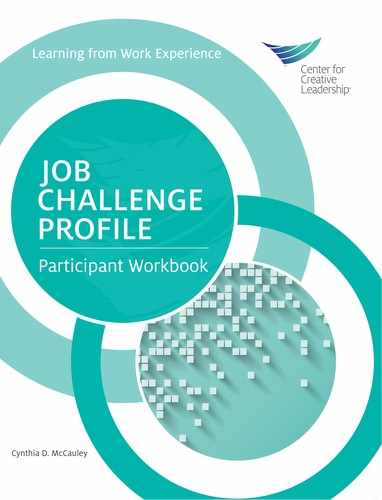Capitalizing on the Learning Potential of Your Job
IN THIS SECTION OF YOUR WORKBOOK, you will examine the learning potential of job components that are particularly relevant for your job in more detail. A summary page is provided for each of the components that provides:
• A description of the job component;
• The managerial skills and perspectives that are most frequently developed from this component; and
• Strategies for getting the most from this component.
At the end of this section, you will be encouraged to consider three additional development strategies—feedback, relationships, and training—to maximize learning in your current job.
Keep in mind as you look at some of the specific developmental components of your job that the same components of your job that offer you the opportunity to learn and grow may also cause you stress and frustration. If you feel discouraged about any aspects of your job that are labeled “challenging,” take heart, as these feelings often accompany learning. Some powerful lessons come from dealing with frustrating situations. One method of dealing with these feelings is to talk to others about the situation. Peers, people who have formerly held your job, mentors, or spouses can help you find the learning points during discouraging moments.
Directions for completing this section:
1. Pick the developmental job components that seem the most important for you, using one or more of the following criteria:
• You rated the component as “quite descriptive” to “extremely descriptive” of your job, that is, your actual score is 20 or higher for the component;
• Your relative score on the component is high; or
• You feel particularly challenged by this component of your job.
2. Work through the summary page for each component you chose in Step 1 above. The page numbers are given below for each component:
• Unfamiliar Responsibilities |
15 |
• New Directions |
17 |
• Inherited Problems |
19 |
• Problems with Employees |
21 |
• High Stakes |
23 |
• Scope and Scale |
25 |
• External Pressure |
27 |
• Influence Without Authority |
29 |
• Work Across Cultures |
31 |
• Work Group Diversity |
33 |
3. When you have finished examining the job components of particular relevance to you, review the section on Linking the Developmental Power of Your Job with Learning Strategies on page 35.
4. Finally, complete the Summary Worksheet on page 38.
Description
You are expected to handle responsibilities that are new or very different for you. This is most likely the result of a job move (a promotion, a transfer, or a move to a new organization), but can also be experienced when a job is redefined due to organizational restructuring, strategic changes in the business, or new work technologies.
This component is characterized by the following:
• A lack of experience in some aspect of the job;
• A noticeable change from the type of work done previously; and
• A lack of background or credentials expected from someone in this position.
Learning Opportunities
If unfamiliar responsibilities are an important aspect of your job, you have the opportunity to learn, particularly in the areas listed in the table below. Do a quick assessment of the degree to which you are learning from unfamiliar responsibilities and fill in the corresponding boxes.

Gaining the Most from Unfamiliar Responsibilities
Do not ignore the new aspects of your job. It is not unusual for a manager to begin a new assignment by focusing most of his or her attention on the familiar parts of the job. Resist this tendency by forcing yourself to spend time on aspects of the job on which you may have a lower comfort level.
Do not be intimidated by a lack of experience. Trial-and-error learning is necessary. Jump in and start learning by doing. Do not let fear that you won’t do something right the first time immobilize you. As a matter of fact, chances are pretty good that you won’t do it exactly right (that’s why they call it trial-and-error learning). Make your mistakes now. Coworkers are more likely to forgive those who are clearly inexperienced.
Discover the tacit responsibilities in the job—aspects that no one explicitly told you about when you took the job. For example, you may be expected to see that positive relationships are maintained between your group and the other department that shares the same floor of the building or your boss may expect you to act on her behalf when she is out of the office. These tacit responsibilities may also be unfamiliar responsibilities to be mastered.
Description
You are responsible for initiating and carrying out something new for the organization, such as a new venture, a new strategic direction, a new process, a new unit, or a new function. There is a need to explore, create, build, and expand.
This component is characterized by the following:
• Something the organization has not tried before;
• Unknown outcomes; and
• A need for new staff, new policies, and new procedures.
Learning Opportunities
If new directions are an important aspect of your job, you have the opportunity to learn, particularly in the areas listed in the table below. Do a quick assessment of the degree to which you are learning from new directions and fill in the corresponding boxes.
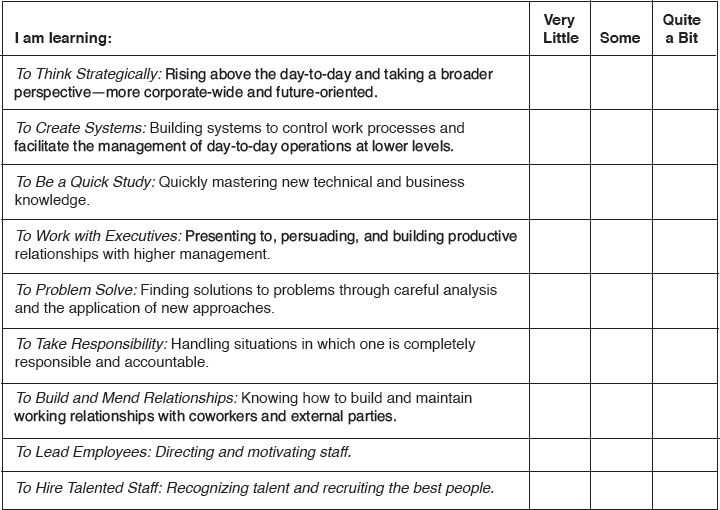
Gaining the Most from New Directions
Be clear about where you are headed. Managers report learning the most when there is a clear vision or goal to give the new initiative direction, but the “how” is still unknown or ambiguous. If the vision or goal seems fuzzy, meet with your boss or senior sponsors to clarify the overall mandate of the change effort.
Expect to navigate, not plan and implement. When launching something new, particularly something the company has not tried before, there is no way to create a detailed plan and then smoothly implement it. There are too many unknowns. Be open to discovering what works and what does not work. Then alter the course as needed.
Build in plenty of feedback loops. Do not expect to wait and evaluate your success at the end of the assignment. Build in ways to find out how the new initiative is unfolding; how people are reacting; what problems are occurring; and what interim outcomes are expected.
Description
You have to fix problems that were created by a predecessor or existed when you took the job. These could be morale problems, performance problems, or credibility issues. You must reexamine strategy, tackle the problems, and restore the group’s image in the organization.
This component is characterized by the following:
• A difficult situation that existed previously;
• Disparate problems to be solved; and
• A need to bring performance back to acceptable levels.
Learning Opportunities
If inherited problems are an important aspect of your job, you have the opportunity to learn, particularly in the areas listed in the table below. Do a quick assessment of the degree to which you are learning from the inherited problems and fill in the corresponding boxes.
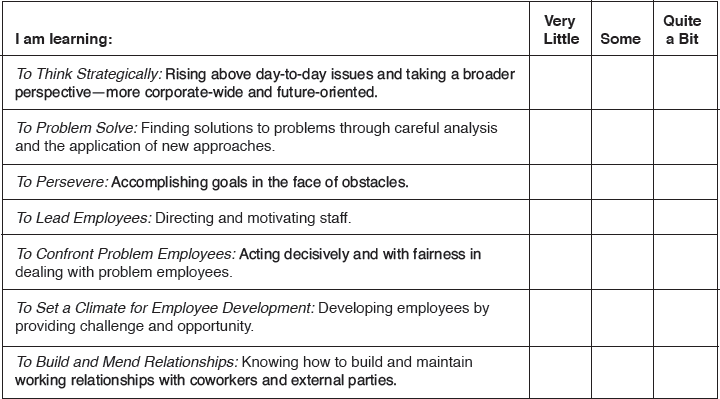
Gaining the Most from Inherited Problems
Dig deep to understand the problems. Most managers who are brought in to fix problems focus first on the most obvious issues and remedies, which is often necessary to stabilize the situation, create positive momentum, and build credibility. But after your first series of actions, take time to reflect on the situation, looking for more subtle factors and deeper, more fundamental causes for the problems.
Enlist your team’s help in solving problems. The people who have been experiencing the problem for some time will have a wealth of insights. You will also hear alternative points of view, which will help you to take a broader perspective. Involving others will also help them to develop the capacity to diagnose problems and improve difficult situations.
Stay in the job long enough to see whether your improvement efforts stick. Have you just created a quick fix or were longer-term benefits realized? Without this feedback, you may have “learned” something that is not true. There is also the danger of becoming a “fix-it” specialist in the organization, brought into a situation to bring it under control and then moving on to handle the next crisis. Although there is much to learn from these challenges, if you only have fix-it assignments, you will not experience the breadth of assignments needed to develop well-rounded managerial competencies.
Description
Your employees lack adequate experience, are incompetent, unmotivated, or resistant. Your challenge is to resolve conflict and improve their performance. Without a competent and supportive staff, you cannot achieve your unit’s goals.
This component is characterized by the following:
• Inadequate employee resources;
• Lack of talent or motivation among the staff; and
• The need for a leader who develops and encourages others.
Learning Opportunities
If problems with employees are an important aspect of your job, you have the opportunity to learn, particularly in the areas listed in the table below. Do a quick assessment of the degree to which you are learning from the problems you are experiencing with employees and fill in the corresponding boxes.
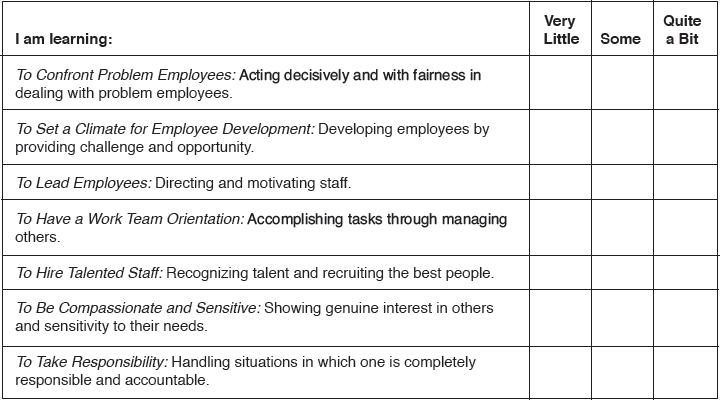
Gaining the Most from Problems with Employees
Do not ignore the problems. Confronting a subordinate about performance problems, skill deficits, or personality conflicts is one of the most dreaded tasks of management, and most managers are seen as not very good at it. Do not pass the problem off to the human resource department (although an HR specialist can be a valuable advisor and coach during the process). If you do, you will be handing off a learning opportunity.
Invest the time and energy needed to improve the situation. Improving problems with employees requires time-intensive activities, such as one-on-one feedback, dialogue to understand the roots of conflict, coaching for improvement, and revamping reward systems. Change and improvement do not happen overnight; they require ongoing and consistent attention.
Work on balancing toughness with compassion. People usually err on one side or the other when trying to deal with subordinate performance or motivation problems. Problems with employees are most often resolved both by insisting that organizational standards and values be met and by empathizing with individual needs and concerns. Analyze your own preferences and identify strategies for being either tougher or more compassionate.
Description
Critical deadlines, pressure from senior management, high visibility, and responsibility for key decisions make success or failure in your job clearly evident to others. Your performance can have significant impact on the organization and on your career path.
This component is characterized by the following:
• Pressure from higher-level management;
• Visibility in the organization; and
• Key responsibilities.
Learning Opportunities
If high stakes are an important aspect of your job, you have the opportunity to learn, particularly in the areas listed in the table below. Do a quick assessment of the degree to which you are learning from your experiences in a high-stakes situation and fill in the corresponding boxes.
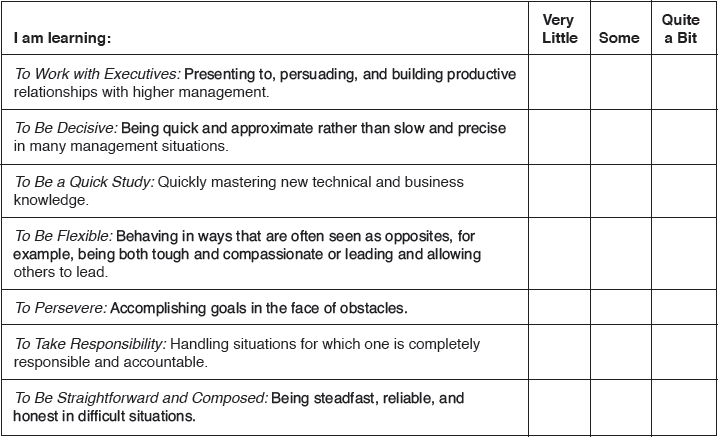
Gaining the Most from High Stakes
Be clear about expectations. You and important stakeholders should discuss and agree on what constitutes success or failure in this situation. When the goals are clear, focus on strategies for reaching them rather than spinning your wheels.
Use a learning orientation. The pressure of a high-stakes situation can easily limit your goals to proving how well you can carry out the responsibilities of the position, that is, a performance orientation. This can limit you to doing what you already can do really well. You will learn more if you also ask yourself, “What do I need to master in this situation that is not already a strength of mine?”
Asking for help is not a sign of weakness. Organizations sometimes mistakenly use a “sink or swim” approach, throwing managers into high-stakes situations to see whether they can handle them. The more productive approach is to provide feedback, coaching, and support during these assignments. If your organization has provided access to people and processes to support you, by all means use them. If it has not, seek out the advice and support you need.
Description
The size of your job is very large, and you have responsibility for multiple functions, groups, products, or services. Coordinating and integrating your multiple responsibilities adds to the complexity of the job, and the size of the job requires considerable energy and resilience.
This component is characterized by the following:
• A broad scope of responsibilities;
• Pressure due to the size of the job; and
• More complexity than you have dealt with in previous jobs.
Learning Opportunities
If broad scope and scale are important aspects of your job, you have the opportunity to learn, particularly in the areas listed in the table below. Do a quick assessment of the degree to which you are learning from your experiences in a broad-scale situation and fill in the corresponding boxes.
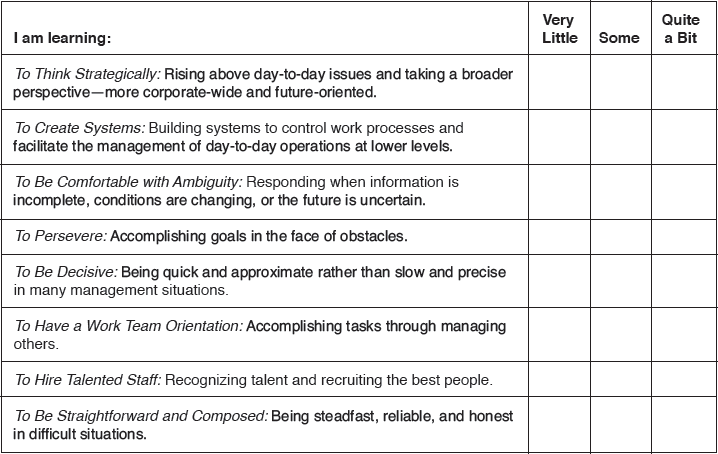
Gaining the Most from Scope and Scale
Be clear about your priorities. Think carefully about where to focus your attention. Learn to delegate other tasks and responsibilities, particularly those that you have mastered. Although you will feel challenged and stretched by the sheer size of your job, the object is to prioritize so as not to be overwhelmed. When you try to do everything yourself, the responsibility becomes too great and learning takes second place to surviving the day-to-day stress.
Look for patterns in the complexity you encounter, for repeated themes. Check whether seemingly disconnected outcomes might influence one another and for synergies created by linking or combining the different activities you manage. Trying to find the “simplicity” on the other side of the complexity will heighten your systems thinking skills and increase your confidence to make decisions with sometimes limited information.
Build in time for reflection. You will be hard-pressed to find the time to consider alternative strategies, examine what seems to be working and what is not, or think through an issue more carefully. Whether it is a special time of the day or week, a person who is your sounding board, or a system for reminding you when you need to reflect, create a deliberate strategy for reflection that will work for you.
Description
You manage the interface with important groups outside the organization, for example, with clients, unions, government agencies, or business partners. Your role is to influence and negotiate with these external groups. The pressure is heightened when the external groups you deal with are diverse, with varied interests and sometimes conflicting demands.
This component is characterized by the following:
• Work with external constituents;
• Separate agendas for the organization and the outside agents; and
• Influence directed outside the organization.
Learning Opportunities
If external pressure is an important aspect of your job, you have the opportunity to learn, particularly in the areas listed in the table below. Do a quick assessment of the degree to which you are learning from your experiences handling external pressure and fill in the corresponding boxes.

Gaining the Most from Handling External Pressure
Strive to understand others’ perspectives. If you are only an advocate for your organization’s views, you close yourself off to learning from others and to finding innovative ways to solve problems or create synergies with outside groups. Learning is enhanced if you heed the adage: “Seek to understand; then be understood.”
Scan the external environment for your organization. Working externally exposes you to trends in the marketplace, new technologies, emerging business issues, and what competitors are doing. Develop ways of synthesizing and sharing what you learn.
Stay in frequent communication with the external parties. Be aware of changes in their situations and keep them updated on what is happening in your organization. After decisions or agreements have been made, follow up to assess the intended and unintended consequences. Ask for feedback on their experiences working with you.
Description
Doing your job requires you to influence peers, higher management, or other key people over whom you have no direct authority. You have to coordinate action across the organization and handle internal politics well.
This component is characterized by the following:
• Work across organizational boundaries;
• Lack of formal authority; and
• The need to exert influence within the organization.
Learning Opportunities
If influence without authority is an important aspect of your job, you have the opportunity to learn, particularly in the areas listed in the table below. Do a quick assessment of the degree to which you are learning from your experiences influencing without authority and fill in the corresponding boxes.

Gaining the Most from Influence Without Authority
View this as an opportunity to see the impact your leadership has on others. In many managerial jobs you work from a position of power. People comply with your decisions and implement them based on your advice because they are part of an organizational structure that gives you authority. When you are working across organizational boundaries and do not have positional authority, you must truly rely on your ability to lead—to motivate others to commit to a course of action because others see the potential positive outcomes of those actions.
Learn the work of other units. Understand the work flow, the customer demands, and the pressures experienced by other groups. Offer to spend time actually working in the groups you need to coordinate with or influence or shadow workers in these units to better understand their situations.
Understand the multiple perspectives within your organization. Every organization is made up of groups that experience different demands (for example, marketing vs. research and development), have been trained in different disciplines, and have evolved different sets of values and beliefs. Seek to understand these different perspectives, why they exist, and how to explain one group’s perspective to another.
Description
You must work with people from different cultures or with institutions in other countries. You may be actually working in a foreign country or working in your own country but managing operations in other countries or key relationships with people outside your country. Any of these activities requires understanding the traditions and values of people from different cultures.
This component is characterized by the following:
• Work with people from different cultures;
• Organizations grounded in different value systems; and
• Management across distances.
Learning Opportunities
If work across cultures is an important aspect of your job, you have the opportunity to learn, particularly in the areas listed in the table below. Do a quick assessment of the degree to which you are learning from your experiences working across cultures and fill in the corresponding boxes.

Gaining the Most from Work Across Cultures
If you are in a foreign culture, experience the culture fully. You might have a tendency to stick with the familiar, interact primarily with other expatriates, continue to rely primarily on your native language, and not risk dealing with practices and customs that make you feel uncomfortable. By “going native,” you will expose yourself to new experiences and different perspectives.
Rely heavily on other people to help you understand a new culture. Do not expect to understand cultural differences on your own. Develop relationships with local nationals who can advise you on appropriate and inappropriate actions. Connect with other people in your organization who have worked in the particular countries you will be working in or with.
Continuously uncover your own assumptions and biases. If people are not responding the way you expect or they do surprising things, ask yourself, “What assumptions am I making here? What does this say about my own cultural biases?” Working across cultures not only makes us aware of other cultures, but also helps us to discover how our own culture has shaped how we see the world.
Description
You work with and manage people of both genders and different racial and ethnic backgrounds. You are responsible for developing and making personnel decisions about a diverse group of people. You must be aware of obstacles in the workplace faced by women and people of color and be able to persuade people from different backgrounds to work together.
This component is characterized by the following:
• Work with diverse people;
• The need to overcome stereotypes and biases; and
• The need to improve people’s ability to work together.
Learning Opportunities
If work group diversity is an important aspect of your job, you have the opportunity to learn, particularly in the areas listed in the table below. Do a quick assessment of the degree to which you are learning from your experiences with work group diversity and fill in the corresponding boxes.

Gaining the Most from Work Group Diversity
Work to understand each individual’s needs and preferences. Do not assume that everyone’s experiences, motivations, and values are like your own. Talk to individuals about what motivates them, what they find challenging, and what kind of support they need from you.
Examine your own stereotypes, assumptions, and biases about who you can work well with, the types of work assignments different people are best suited for, and whom you would seek advice from. Think whether some people have to “prove themselves” to a greater degree for you to accept them.
Encourage others in your group to examine their stereotypes, assumptions, and biases also. Teach them the importance of understanding individual needs and preferences. Create safe settings for group members to discuss these sensitive issues.
Linking the Developmental Power of Your Job with Learning Strategies
Now that you have focused on some aspects of your job that can provide opportunities to learn and grow, let’s review some general learning strategies that can increase your capacity to learn from your job: feedback, relationships, and training. Each is explained below. After each description, take a moment to write how you think this approach can help you on the job.
Feedback
Feedback is data that tells you how well you are doing. For job assignments, feedback is often built right into the work. Did an action have a positive outcome? Did people act on the advice you gave? To increase the amount of feedback you receive, you may want to build in some more formal feedback mechanisms. This could be accomplished in several ways: (1) you could set up meetings in which you ask for feedback from your boss and other key stakeholders, either on a regular schedule or after key tasks have been completed; (2) your boss or a member of the HR staff could gather the feedback from others and share it with you; (3) you could enlist the help of a trusted colleague or mentor to give you feedback in specific areas, asking the person to be on the lookout for certain behaviors, such as how you handle pressure or how you work with senior managers; or (4) your organization could offer opportunities for formal feedback using 360-degree assessment tools.
• Take a moment to write down some ideas on how you can increase the amount of feedback you receive in your job.
Just as other people can be a source of feedback, they can also be a source of advice and support. Learning from a challenging assignment is enhanced if you have relationships with people who can share their expertise, serve as sounding boards, and help you problem solve. Learning is also enhanced if you receive encouragement, empathy, and reinforcement from others. Although having a mentor or coach can be particularly useful during a developmental assignment, do not rely on one person. Cultivate multiple relationships to serve the various needs you might uncover as you try to learn and grow in your job. The former job incumbent might be a good source of knowledge about some of the unfamiliar aspects of the job, whereas a close colleague might be a good person to turn to for encouragement.
• Take a few minutes to write down the types of relationships you could develop to enhance your learning in your job.
Formal training programs can help you to develop knowledge and skills you need to deal with job challenges. Training programs generally focus on specific knowledge or skills, for example, strategic planning or communication. Effective training programs can provide new tools and strategies, opportunities to practice, feedback on how well you are doing, and ideas on how to put into practice the knowledge and skills you have worked on in the program. Training programs are particularly effective when the content of the program is focused on a current job challenge. In this case, you can quickly begin practicing what you learned. For example, a training program focused on negotiation skills would be particularly timely if one of your key challenges were Influence Without Authority.
• Take a few minutes to write down some of the types of training programs that would be helpful for you as you face your current job challenges.
You have just examined your job responsibilities and challenges from a new perspective—looking at your job as a learning opportunity. You have reviewed your Job Challenge Profile scores, focused on the developmental job components specific to your job, and reflected on how other learning strategies can be utilized.
Now answer the questions below to help you reflect on your insights for capitalizing on the learning potential of your job.
1. To what degree is my job contributing to my ongoing development as a manager? What management skills am I learning? How am I developing as a person?
2. What components of my job should I see as learning opportunities? How can I take better advantage of them?
3. What can I do to learn the most from my job experiences? What new strategies should I try? What obstacles will I need to overcome?
